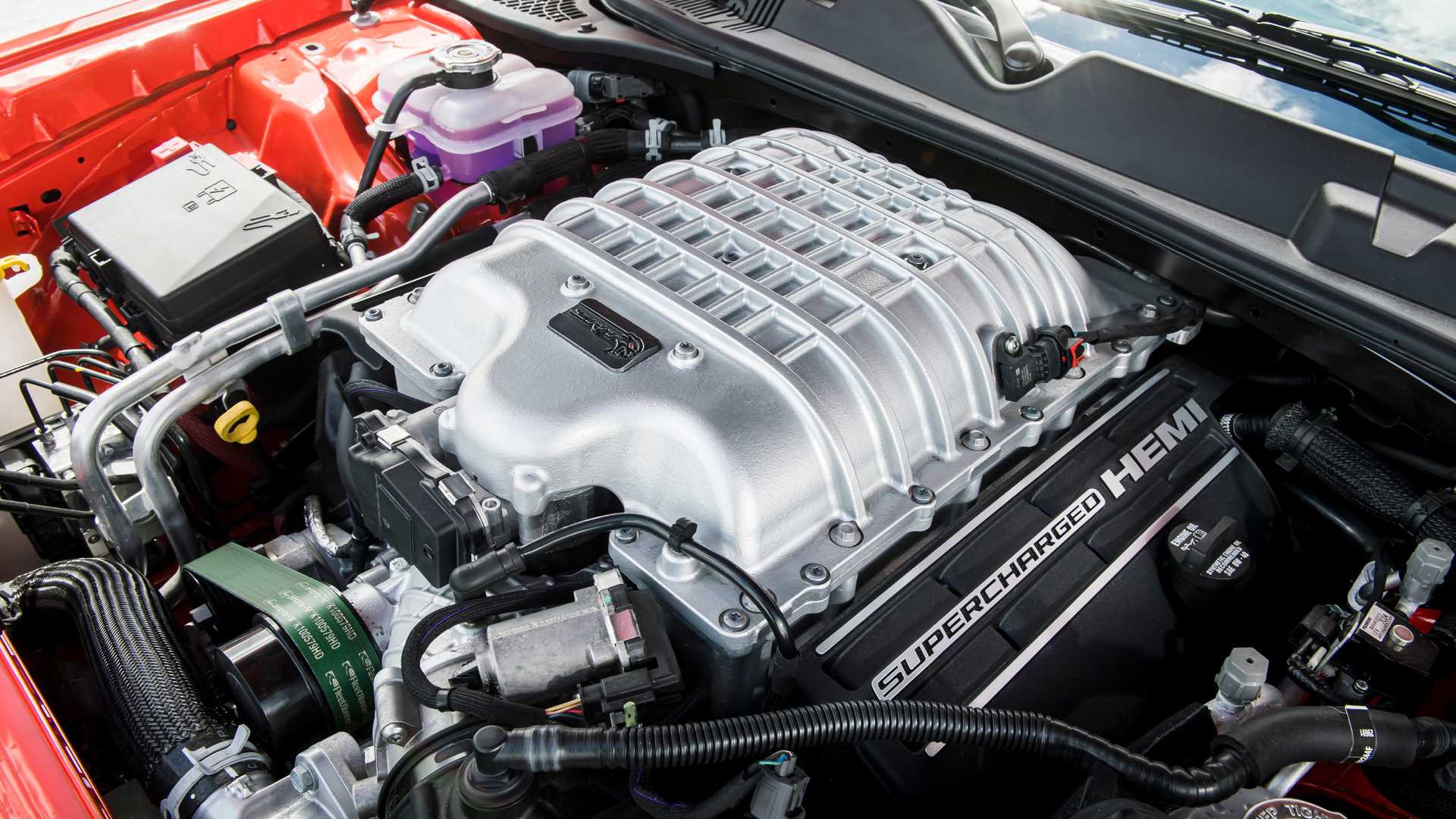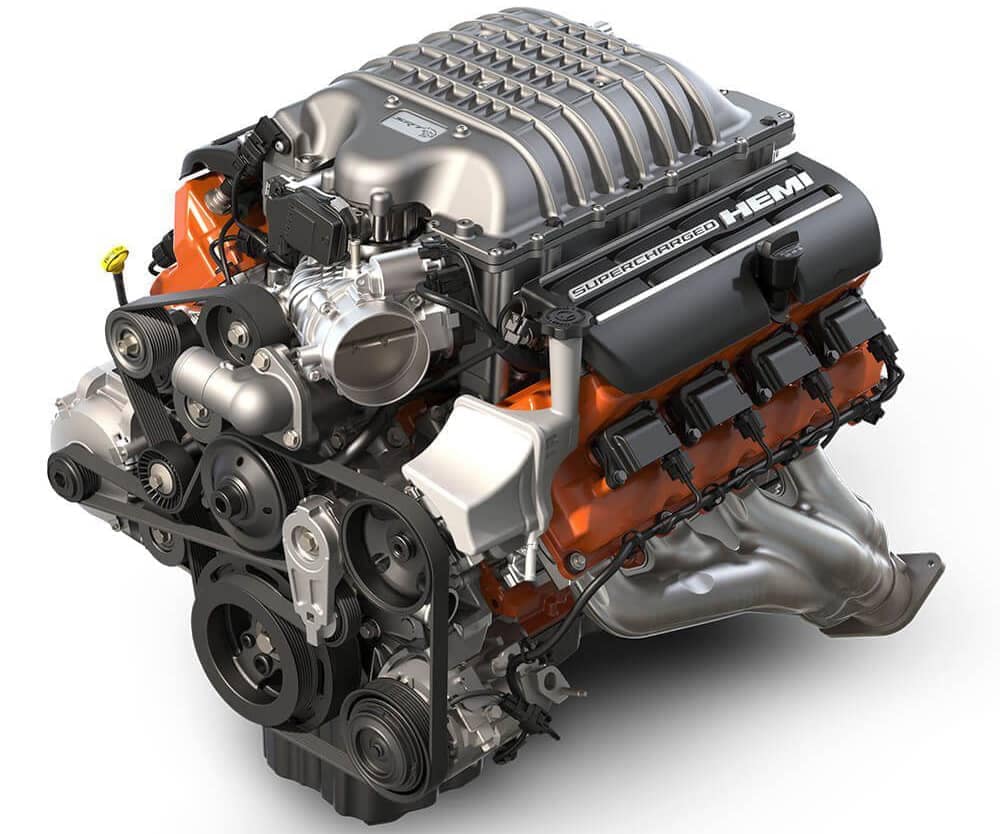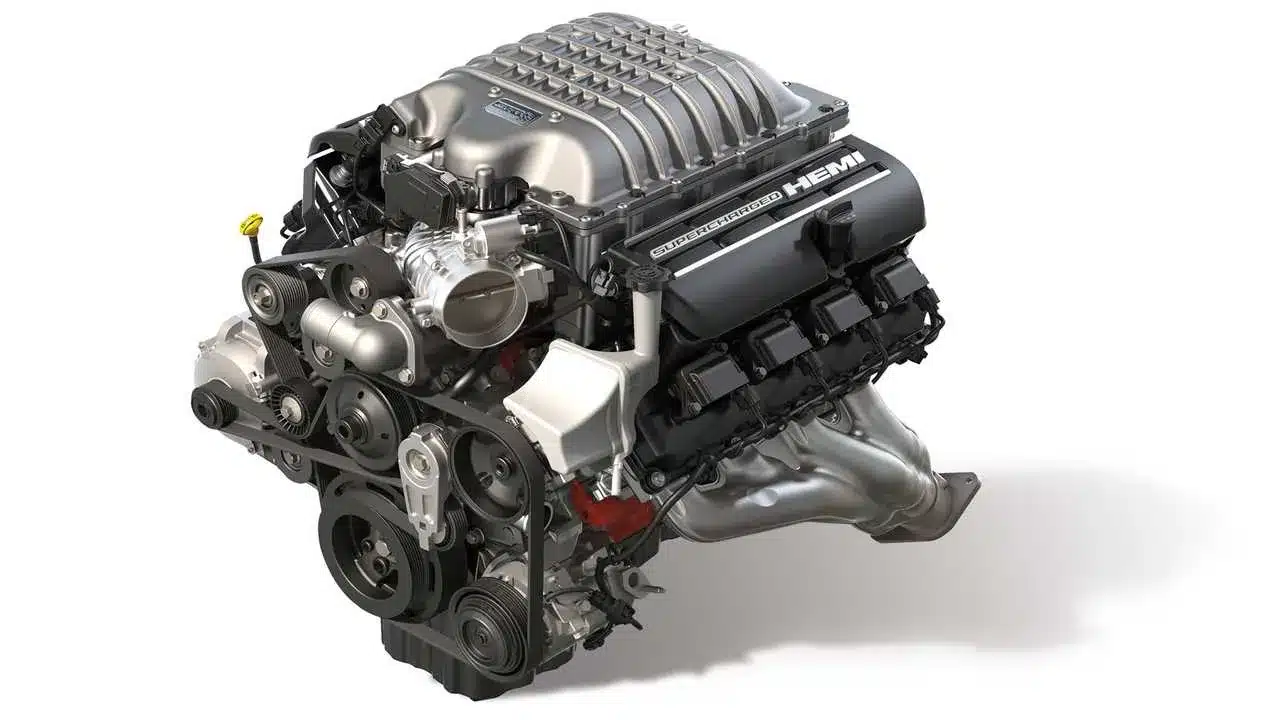If you have any exposure to the world of powerful automobiles, you are probably familiar with hearing the term HEMI in passing. These unique engines provide exceptional reliability, durability, and power.
Chrysler HEMI engines arrived in the auto industry back in 1951 and continued to evolve through the years. Its distinct features offer overhead valve hemispherical combustion chambers. These elements create better combustion with a minimal amount of heat loss.
The 6.2 HEMI® engine is in a class all its own. This Chrysler-built engine takes a different approach than other models to provide an exceptional piece of craftsmanship that continues to offer a powerful and durable engine.
More specifically, the 6.2 HEMI is a high-performance, supercharged variation of the older HEMI models. It is available in two options, the Hellcat and the Demon.
6.2 HEMI® V8 – Engine Specifications – Hellcat & Demon
To get a better idea of what makes the 6.2 HEMI® V8 special, we have to dive into the 6.2 HEMI specs and how it differs. Although both models use twin-screw superchargers, there are variances.
Here are the 6.2 HEMI specs:
| Manufacturing Plant | Saltillo Engine Plant, Ramos Arizpe, Coahuila, Mexico |
| Years of Production | 2015 to present |
| Vehicles | Dodge Challenger SRT Hellcat, Dodge Charger SRT Hellcat, Jeep Grand Cherokee Trackhawk, Dodge Durango SRT Hellcat, Ram 1500 Rebel TRX Concept, Ram 1500 TRX, Dodge Challenger SRT Demon |
| Engine Type | Four-stroke, naturally aspirated |
| Configuration | V-engine |
| Number of Cylinders | 8 |
| Valves Per Cylinder | 2 |
| Valvetrain Layout | Overhead valve (OHV) 2V |
| Displacement (in cc) | 376.3 cu in |
| Power (in hp) | 707 – 840 hp |
| Torque (in lb-ft) | 656 – 770 ft-lb |
| Max RPM | 6500 |
| Compression Ratio | 9:5:1 |
| Bore | 103.9 mm (4.09 in) |
| Stroke | 94.6 mm (3.72 in) |
| Firing Order | 1-8-4-3-6-5-7-2 |
| Engine Weight | 227 – 312.9 kg (500 – 690 lbs) (dry weight) |
| Cylinder Block Material | Cast Iron |
| Cylinder Head Material | Aluminum Alloy 356 |
| Exhaust Manifold Material | Fabricated Tubular |
| Intake Manifold Material | Aluminum Fixed runner length / Composite, Variable runner length |
| Oil Sump Material | Aluminum / Steel |
| Fuel Type | Gasoline – racing fuel |
| Fuel Injection System | Supercharged PFI |
| Engine Oil Weight | Synthetic 0W-40 |
| Oil Capacity | 6.6 L (7.0 qt) |
| Oil Change Interval | 5,000 – 6,000 miles / 6 months |
Hellcat Engine Specs
Starting with the Hellcat SRT, speed lovers will enjoy the supercharged intercooled pushrod 16-valve V8 engine with a cast iron block and aluminum heads. It contains a port fuel injection and pairs with an 8-speed automatic transmission.
It offers a 103.9 mm bore and 90.9 mm stroke, and boasts a whopping 717 horsepower and 656 pound-feet of torque, putting many other vehicles to shame. Its 2.4-liter twin-screw supercharger produces 11.6 psi of boost.
The supercharger displacement is 376 cubic inches, with a peak RPM of 6200 and a compression ratio of 9:5:1. Chrysler also included variable valve timing with this variation, although they avoided variable displacement.
This Hellcat 6.2 HEMI weight is an outstanding 500 pounds, making it on the lighter side of standard V8s in the market.
Redeye SRT and the SRT Super Stock contain a larger 2.7-liter twin-screw supercharger to create 14.5 psi and enable 807 horsepower and 707 pound-feet of torque. This additional boost enables the 6.2 HEMI engine to reach 6500 RPM and requires two fuel pumps rather than one.
So, let’s get right into the nitty gritty of each 6.2 supercharged HEMI engine.
Demon Engine Specs
Exploring the Demon SRT will bring you a supercharged 6.2 HEMI V8 that boasts some desirable upgrades from the Hellcat model.
The engine block is cast iron with aluminum alloy heads. It has a flatter combustion chamber design with a coil-on-plug dual ignition system in place for two spark plugs per cylinder.
Drivers can experience the impressive 808 horsepower and 717 pound-feet of torque with the Demon HEMI. Its 2.7-liter twin-screw supercharger produces a 14.5 psi boost for that get-up-and-go many speed lovers crave.
The supercharger displacement is 376 cubic inches, with a peak RPM of 6500 and a similar compression ratio as the Hellcat at 9:5:1. In addition, the Demon contains upgraded forged pistons, connecting rods, and crankshaft to handle this extra power.
Alternatively, speed lovers can opt for installing the new ECU from the Demon Crate to unlock further capabilities. This upgrade will produce 840 horsepower and 770 pound-feet of torque when using racing fuel.
6.2 HEMI® V8 – Info (Short History) – Hellcat & Demon
The 6.2 HEMI V8 has evolved through the years, with each model offering more than the previous one.
Chrysler originally introduced the HEMI back in 1951 and coined it the FirePower Engine. This first model remained in production until 1958.
The second HEMI engine variation came shortly after in 1964. This one carried the iconic HEMI® name although its nickname was the Elephant Engine due to its intense power, heavy weight, and large size. This second-generation HEMI included racing and street options, which contained several differences. Chrysler stopped production of this engine in 1971.
Then, in 2003, Chrysler picked up where they left off and reintroduced the HEMI engine once more with vigor in their third-generation models. It is in these newer releases that the Chrysler 6.2 HEMI came to be.
It all started with the 5.7 HEMI engine in 2003, with revisions following in 2009. It appeared on the Ward’s 10 Best Engines list for several years, including 2003 to 2007, and in 2009. This model is found in the following vehicles:
- 2003 and up: Ram Pickup
- 2004 to 2009, 2011 and up: Dodge Durango
- 2005 to 2008: Dodge Magnum R/T
- 2005 and up: Chrysler 300C, 300S V8 (2010, 2012 and up)
- 2005 and up: Jeep Grand Cherokee
- 2006 and up: Dodge Charger R/T
- 2006 to 2010: Jeep Commander
- 2007 to 2009: Chrysler Aspen
- 2009 and up: Dodge Challenger R/T
- 2022 and up: Jeep Wagoneer
Then, in 2005, the next model of HEMI appeared in the 6.1 variations. It has several changes from the 5.7, including lighter pistons, a forged crankshaft, and a cast aluminum intake manifold. Consequently, the 6.1 does not use Chrysler’s Multi-Displacement System.
You can find the 6.1 HEMI in these vehicle applications:
- 2005 to 2010: Chrysler 300C SRT-8
- 2006 to 2008: Dodge Magnum SRT-8
- 2006 to 2010: Dodge Charger SRT-8
- 2006 to 2010: Jeep Grand Cherokee SRT-8
- 2008 to 2010: Dodge Challenger SRT-8
In 2015, the world was introduced to the all-new supercharged 6.2 HEMI that came with the Hellcat name. At the time, it was the most powerful engine produced by Chrysler to date, and the most powerful option for a muscle car. That is, until the Demon followed suit.
The 6.2 Hellcat resides in these vehicles:
- 2015 and up: Dodge Challenger SRT Hellcat
- 2015 and up: Dodge Charger SRT Hellcat
- 2018 and up: Jeep Grand Cherokee Trackhawk
- 2021: Dodge Durango SRT Hellcat
- 2017: Ram 1500 Rebel TRX Concept
- 2021and up: Ram 1500 TRX
Only a few short years later, Dodge aimed to create an engine that could produce a 9-second quarter-mile and lift the front wheels off the ground at launch. They were successful with the Dodge 6.2 HEMI Demon model.
6.2 HEMI® V8 – Overview – Hellcat & Demon
The Hellcat SRT is available in six different models which offer between 717 to 807 horsepower and 656 to 707 pound-feet of torque. These variations include:
- SRT Hellcat
- SRT Hellcat Widebody
- SRT Hellcat Redeye
- SRT Hellcat Redeye Widebody
- SRT Super Stock
- SRT Hellcat Redeye Widebody Jailbreak
This popular engine choice is an integral part of many vehicles through Chrysler and Dodge, including:
- 2015 and up: Dodge Challenger SRT Hellcat
- 2015 and up: Dodge Charger SRT Hellcat
- 2018 and up: Jeep Grand Cherokee Trackhawk
- 2021: Dodge Durango SRT Hellcat
- 2017: Ram 1500 Rebel TRX Concept
- 2021 and up: Ram 1500 TRX
6.2 HEMI® V8 – Advantages and Disadvantages – Hellcat & Demon
Naturally, each 6.2 HEMI V8 will have its advantages and disadvantages. However, the relevance of these factors is up to the individual’s preferences. So, let’s compare some of these between the Hellcat and Demon engine choices.
Speed
The 6.2 HEMI V8 Hellcat can get from 0 to 60 miles per hour in an impressive 3.4 seconds and reaches a quarter-mile in 10.9 seconds. However, the Demon is not to be outshined, and tops that by reaching this speed in only 2.3 seconds and a quarter-mile at 9.65 seconds.
Although for many racing enthusiasts, faster is better, not every driver will need a sports car that can be an under-10 contender. For the Demon to reach these top speeds and impressive results, it does require racing fuel, putting the average car owner at a disadvantage for using all its capabilities.
Both 6.2L HEMI engines have an 8-speed automatic transmission. However, the Hellcat has an advantage by offering the choice of a 6-speed manual transmission as an alternative.
Engine Cooling
To help engine cooling, the Hellcat uses unique air-catching headlamps to feed cold air into the airbox. Alternatively, the Demon sports a massive hood scoop to funnel air, but also uses a liquid-to-air charge air cooler chiller system.
In layman’s terms, it redirects the air conditioning to the engine to help improve cooling for better performance. So, if you prefer to race during those hot summer months, the Demon has a bigger cooling advantage over the Hellcat.
For sports car enthusiasts concerned with overpowering the braking system, the Demon comes with a unique Transbrake feature. This addition is new to the Demon and is not available in the Hellcat, allowing drivers to accelerate up to 2350 RPM without worrying about overpowering the brakes.
HEMI Advantages
There are some across-the-board advantages to having a Chrysler HEMI engine. The unique design of these models has a smaller surface area than traditional engines, which makes them more efficient for burning fuel, and minimizes heat loss during combustion.
When a 6.2 HEMI engine contains hotter fuel, it burns more effectively, and allows it to run optimally without wasting energy.
Another significant advantage to this engine model is the valve placement. Unlike standard engines with side-by-side positioning, the HEMI valves sit on opposite sides of their chamber. This spacing enables bigger valves, which increase airflow through the engine during operation, and better performance.
HEMI Disadvantages
Even with all these benefits to the 6.2 HEMI engine, there are some drawbacks.
One of the most significant disadvantages is the limitations of valves per cylinder. This model cannot accommodate four valves per cylinder, and offers only two. Many auto enthusiasts prefer four smaller valves for better airflow in a smaller combustion engine.
There is no denying that the HEMI is costly compared to other high-performance engines. It is more expensive to produce, and it can be heavier than the alternative wedge head model.
In addition, it goes without saying that a high-performance engine like the 6.2 HEMI, will cost drivers a lot more in fuel, especially if they prefer to drive at high speeds regularly. This model is not your most cost-effective choice for a powerful Chrysler engine, unfortunately.
6.2 HEMI® V8 – Engine Problems and Reliability – Hellcat & Demon
No vehicle is without problems or faults, unfortunately. Although a manufacturer may put extra effort into a high-performance engine like the 6.2 HEMI V8, owners may still encounter some situations later on.
However, the 6.2 HEMI problems that occur with these engines include their longevity. They are notorious as a reliable and durable option for 200,000 miles or more with proper maintenance and care. Naturally, if these engines reside in sports cars that are driven hard, then owners should take care to ensure more rigid maintenance schedules to keep them in optimal shape.
In addition, knowing some common engine problems and possible issues can ensure sports car enthusiasts choose the best vehicle for their needs.
Hellcat Recalls
Looking at the Hellcat, it has one active recall currently. This recall applies to specific 2017 Dodge Charger Hellcats and 2017 Dodge Challenger Hellcats.
It includes details about an engine oil cooler hose that may come loose, which can cause rapid oil loss, resulting in impaired vision of the windshield, increase the chance of fire, or cause engine damage.
Demon Recalls
The Demon is not immune to engine recalls either. This impressive masterpiece has an active recall for 1930 vehicles with a possible faulty wiring issue.
In a large country-wide recall that affects other Chrysler vehicles, the 2018 Dodge Challenger SRT Demon can experience a short circuit with the powertrain control module (PCM), causing the cruise control to remain on. Applying the brakes does not disengage the cruise control, making this recall an extremely risky one to forget.
6.2 HEMI V8 Upgrades
Hellcat Upgrades
No high-performance vehicle will roll off the lot without having options for upgrades. Depending on the vehicle of your choosing, the Hellcat upgrades include:
- Hellcrate 6.2L HEMI
- Mopar Hellephant crate engine
- 6.2L Supercharged Crate HEMI engine kit
- Hellcrate Redeye Supercharged 6.2L HEMI engine
- Demon Crate
- Hellcat Redeye Pre-Stage Kit
- Direct Connection Pre-Stage Kits
- 6.2L Supercharged Crate HEMI® Engines FEAD Basics Kit
- A/C Expansion Kit for 426 & 6.2L Supercharged Crate HEMI® Engines
6.2L Hemi® V8 Engines: Demons, Hellcats, and Redeyes
By now, you should have a better understanding of the foundations of the Third-Generation 6.2L HEMI V8 engine and its many features. For those speed and power junkies out there, this option is one of the better choices for an efficient and fast motor.
The 6.2L HEMI engine continues to be a force to reckon with. And just when you thought it could not get any more powerful, after the first release in 2015, many upgrades followed, making each one better than the last.
So whether you are shopping for an entirely new vehicle or a separate crate engine, the 6.2L HEMI is an excellent choice for many racing enthusiasts. All you need to do after is make sure you do up your seatbelt!
6.2 HEMI® V8 – FAQ
Here are a few common questions regarding the 6.2L HEMI V8 engine.
What is the name HEMI short for?
HEMI is the shortened version of the word hemispherical. This engine uses a hemispherical combustion design, making it unique from other standard options.
Where does the name Hellcat come from?
The Hellcat name comes from the Grumman F6F Hellcat, a WWII-era fighter plane built at the company’s former factory in Bethpage, NY.
Are all 6.2L V8 engines a Hemi®?
No, not every 6.2L V8 engine is a Hemi®. The Hemi® is a trademark of Chrysler and refers to a specific type of engine with a hemispherical design.
Are the Hemi® 6.2L engines reliable?
In general, Hemi® engines are quite reliable. The Hemi® 6.2L has some serious, performance-oriented construction. While they are not bulletproof, they are among the most reliable performance engines.


